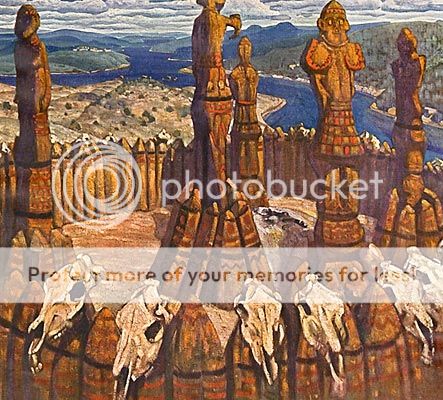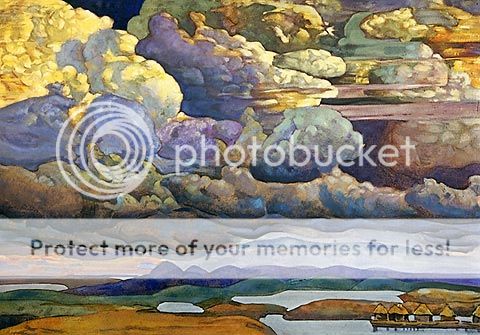 Glancing through the news the other day, my eye was caught by the headline "The Mountains of Madness." The article was about an expedition to the Gamburtsev Mountain Range in central Antarctica. The mountains were discovered 50 years ago in the International Geophysical Year of 1958. This year (2008) is the International Polar Year, and a team of scientists has returned to the Gamburtsevs to try, among other things, to explain their formation. But the headline itself, "Mountains of Madness," is an allusion to a novella by science fiction author H. P. Lovecraft, At The Mountains of Madness, written in 1931.
Glancing through the news the other day, my eye was caught by the headline "The Mountains of Madness." The article was about an expedition to the Gamburtsev Mountain Range in central Antarctica. The mountains were discovered 50 years ago in the International Geophysical Year of 1958. This year (2008) is the International Polar Year, and a team of scientists has returned to the Gamburtsevs to try, among other things, to explain their formation. But the headline itself, "Mountains of Madness," is an allusion to a novella by science fiction author H. P. Lovecraft, At The Mountains of Madness, written in 1931.
Lovecraft is at best an acquired taste. He is generally described as a writer of horror or Gothic stories. His style is clear and his imagery quite visual, if his subject matter tends toward the alien and demonic. I read many of his stories as a teen, but hadn't revisited them since. After seeing the headline though, I thought I would try him again and see what I thought. His works are available for download at Project Gutenberg Australia.
 First I read The Colour out of Space, a Gothic tale about an asteroid which crashes to earth in a small New England town, bringing with it a malevolent alien influence. The story was not very enthralling. Told as a flashback, and with no human conflicts, it lacked any real drama. But one thing was of interest. Lovecraft was apparently fascinated with science, and he mentioned several phenomena with which I was unfamiliar, including Widmanstätten patterns, which he mentioned were revealed when a cut section of the meteorite was treated with acid. Unfamiliar with the term, and suspecting he might simply have made it up, like some technology out of a Star Trek episode, I checked with Wikipedia. It turns out such beautiful fractal patterns do indeed exist, and I have pictured them here.
First I read The Colour out of Space, a Gothic tale about an asteroid which crashes to earth in a small New England town, bringing with it a malevolent alien influence. The story was not very enthralling. Told as a flashback, and with no human conflicts, it lacked any real drama. But one thing was of interest. Lovecraft was apparently fascinated with science, and he mentioned several phenomena with which I was unfamiliar, including Widmanstätten patterns, which he mentioned were revealed when a cut section of the meteorite was treated with acid. Unfamiliar with the term, and suspecting he might simply have made it up, like some technology out of a Star Trek episode, I checked with Wikipedia. It turns out such beautiful fractal patterns do indeed exist, and I have pictured them here. Next, I decided to read the longer work, At the Mountains of Madness, to which the headline had alluded and which I had remembered particularly liking as a teen. The story involves an expedition to a massive mountain range in the central wastes of Antarctica. Journeying inward the adveturers discover the remains of an ancient, alien civilization, finding to their horror that even after millions of years there is still some living presence in the cyclopean ruins. Once again I was struck by an allusion of Lovecraft's. Upon first encountering the alien habitations in the mountains, his protagonist describes them as "like the old Asian castles clinging to steep mountains in Roerich's paintings." Who was Roerich? Curious, I again checked Wikipedia, and came across an interesting artist, Nicholas Roerich, seven of whose works I have reproduced here.
Next, I decided to read the longer work, At the Mountains of Madness, to which the headline had alluded and which I had remembered particularly liking as a teen. The story involves an expedition to a massive mountain range in the central wastes of Antarctica. Journeying inward the adveturers discover the remains of an ancient, alien civilization, finding to their horror that even after millions of years there is still some living presence in the cyclopean ruins. Once again I was struck by an allusion of Lovecraft's. Upon first encountering the alien habitations in the mountains, his protagonist describes them as "like the old Asian castles clinging to steep mountains in Roerich's paintings." Who was Roerich? Curious, I again checked Wikipedia, and came across an interesting artist, Nicholas Roerich, seven of whose works I have reproduced here. Nicholas Roerich (1874-1947) was a painter, archeologist, philosopher and Orientalist from St. Petersburg, Russia. An accomplished illustrator and folklorist, he suggested the subject, collaborated with the composer, and did the stage designs for the riotous Paris debut of Stravinsky's Rite of Spring, subtitled "Pictures from Pagan Russia." He was thrice nominated for the Nobel Peace prize for his work to preserve cultural artifacts. He was a noted theospohist and painted on Buddhist, Pagan and Eastern Orthodox Christian themes. His life and work are featured at the Roerich Museum (here is their website) here in Manhattan. I hope to visit it soon. Here we see an accurrate depiction of a Pagan shrine, probably in the Altai Mountains of Greater Mongolia.
Nicholas Roerich (1874-1947) was a painter, archeologist, philosopher and Orientalist from St. Petersburg, Russia. An accomplished illustrator and folklorist, he suggested the subject, collaborated with the composer, and did the stage designs for the riotous Paris debut of Stravinsky's Rite of Spring, subtitled "Pictures from Pagan Russia." He was thrice nominated for the Nobel Peace prize for his work to preserve cultural artifacts. He was a noted theospohist and painted on Buddhist, Pagan and Eastern Orthodox Christian themes. His life and work are featured at the Roerich Museum (here is their website) here in Manhattan. I hope to visit it soon. Here we see an accurrate depiction of a Pagan shrine, probably in the Altai Mountains of Greater Mongolia. Roerich travelled through Asia and the Russian Orient. He documented the area's geography and cultural artifacts and painted real, historical, and mythological landscapes and events. His style is notable for its stylization, color, clarity and dynamic themes. He is not a great figurative artist. His human figures are simple. Nature, rather than man, plays the central role in his works. But he does depict themes which evoke wonder and awe, and subjects of epic beauty. Here in Ashram we see his typical combination of the contemplative individual set in a monumental landscape of brilliant color. Note the Hindu religious iconography on the rocks.
Roerich travelled through Asia and the Russian Orient. He documented the area's geography and cultural artifacts and painted real, historical, and mythological landscapes and events. His style is notable for its stylization, color, clarity and dynamic themes. He is not a great figurative artist. His human figures are simple. Nature, rather than man, plays the central role in his works. But he does depict themes which evoke wonder and awe, and subjects of epic beauty. Here in Ashram we see his typical combination of the contemplative individual set in a monumental landscape of brilliant color. Note the Hindu religious iconography on the rocks.
Visitors from Overseas, directly above, depicts the Varangians, Norse Vikings who explored the waterways of Russia, travelling as far as Constantinople and the Caspian. The Varangians or Varyags are mentioned in Tolkien's Lord of the Rings as a people decieved by Sauron, and Michael Crichton's Eaters of the Dead (adapted as the movie The Thirteenth Warrior) tells the tale of Beowulf from the perspective of an Arab adventurer who travels with Varangians from Baghdad to Denmark and back. (In an interesting twist in light of this essay, Crichton actually cites Lovecraft's fictional Necronomicon in the biography to his book.)
 The Arcadian painting For Snegurochka (the Snow Maiden) is a set design for an Operatic adaptation of the Tale by Nikolai Rimsky-Korsakov. Of a similar theme to The Little Mermaid, Snegurochka is the subject of Russian fairy tales, where she is depicted as the granddaughter of Father Christmas, or as a creation out of snow. Longing to love a mortal man she is granted her wish but at the cost of her immortality.
The Arcadian painting For Snegurochka (the Snow Maiden) is a set design for an Operatic adaptation of the Tale by Nikolai Rimsky-Korsakov. Of a similar theme to The Little Mermaid, Snegurochka is the subject of Russian fairy tales, where she is depicted as the granddaughter of Father Christmas, or as a creation out of snow. Longing to love a mortal man she is granted her wish but at the cost of her immortality. Descent into Hell is one of Roerich's religious works. Here we see Christ after his crucifiction but before his resurrection descending into Sheol. According to Christian belief, Christ takes upon the suffering of man, not only on the cross, but also in the afterlife. He travels to hell, throws open the gates, and allows those in the grace of God to depart. Here, in place of devils, Roerich uses deep sea angler fish, a recently discovered demonic denizen of the deep.
Descent into Hell is one of Roerich's religious works. Here we see Christ after his crucifiction but before his resurrection descending into Sheol. According to Christian belief, Christ takes upon the suffering of man, not only on the cross, but also in the afterlife. He travels to hell, throws open the gates, and allows those in the grace of God to depart. Here, in place of devils, Roerich uses deep sea angler fish, a recently discovered demonic denizen of the deep.
Battle of the Heavens, directly above, depicts a theme common to the Eurasian Steppe. The vast plains of Central Aisa, like the Tornado Alley of the American Midwest, are an area of dramatic meteorological phenomena. The worship of Father Sky has roots in the fascination of the Hyperboreans with great storms and standing cloud formations that exist where the Jet Stream, passing over the high mountains of Central Asia, causes animated hovering storm clouds to condense.
You can read about Nicholas Roerich at Wikipedia and check out Roerich's artwork the Nicholas Roerich Museum.
1 comment:
i've been reading lovecraft myself recently and have wondered who roerich was, as he is repeatedly referenced in at the mountains of madness. his paintings are beautiful indeed! perhaps i will now have a better visual sense of the scale of lovecraft's imaginations.
Post a Comment